|
|
|||||||||||
|
|
|||||||||||
 |
|||||||||||
|
|
|||||||||||
|
![]()
|
Xinyi Liuhe Quan - the secret art of Chinese Muslims Part One - Brief History by Jarek Szymanski |
| Text - Jarek Szymanski; photos - Jarek
Szymanski and from author's collection © J.Szymanski 2002 |
Xinyi Liuhe Quan (literally - Fist of Mind, Intention and Six Harmonies) is a martial art that has developed in Henan Province among Chinese Hui (Moslem) nationality. It is considered one of the most powerful and fighting-oriented styles among other Chinese Martial Arts, and for a long time it has been known for its effectiveness in fighting, while very few actually knew the practice methods of the style. Xinyi Liuhe Quan, along with Cha Quan and Qi Shi Quan (Boxing of Seven Postures), have been considered "Jiao Men Quan" ("religious - e.g. Moslem - boxing") meant to protect followers of Islam in China. |
| For more than two
centuries the style had been kept secret and transmitted only to very few Moslem practitioners. Only at the beginning of this century first native Chinese (Han
nationality) learnt the style, but still up to now the most skilful experts of Xinyi Liuhe Quan can be found within Hui communities in China. Since the arts of Xinyi and Xingyiquan are generally divided into Hebei, Shanxi and Henan branches, the style is also called Henan Xinyi/Xingyi. In the West the style is often referred to as Ten Animals Xingyi. The early history of the style is not very clear. According to "Preface to Six Harmonies Boxing" ("Liuhequan Xu") written in 1750, the style was created by Yue Fei who "as a child learnt from a master of deep knowledge and became very skilful at spear play; (on this basis) he created a boxing method to teach his officers and called it "Intention Boxing" (Yi Quan); (the martial art was) marvelous and ingenious, unlike any other before. After the King (e.g. Yue Fei) (passed away), during Jin, Yuan and Ming dynasties the art was rarely seen. Master Ji, called Ji Jike, also known as Ji Longfeng living at the end of Ming and beginning of Qing dynasties in Zhufeng of Pudong (today's Zun Village in Shanxi Province), went to Zhongnan Mountains to visit teachers with deep knowledge there and received the boxing manual of King Wumu (e.g. Yue Fei) (...)". |
The art of Xinyi Liuhe Quan was passed secretly among Chinese Moslems and has been known as "the most cruel style among Chinese martial arts" |
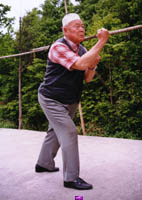 |
|
| Above: Horse Shape - one of Ten Big Shapes of Henan Xinyi Liuhe Quan |
|
According to "Ji Clan Chronicles" (Ji Shi Jiapu) Ji Longfeng's spear skill was extraordinary and he was known as "Divine Spear" (Shen Qiang). Ji (also known as Ji Jike) created a fist boxing using spear principles and taught in Henan. These two texts talk about creating martial art on the basis of spear, although the first one attributes it to Yue Fei, while the other one - to Ji Longfeng. Recently one of Chinese martial arts magazines published an article about a discovery of a new branch of Xinyiquan, related neither to Moslem nor Dai Family. The style is practiced only in a very small community in a small village in Henan Province. Many facts seem to support the thesis that the style is a "living remain" of Yue Fei's boxing from before Ji Longfeng's times. For example - one of the rules of that style does not allow to pass the boxing to people with the last name Qin - probably because Yue Fei was betrayed (which resulted in death sentence) by Qin Hui, minister in Song court. The style shows some similarity to other Xinyi branches, but its movements are more simple, methodology of Neigong (internal exercises) is practically non-existent and emphasis is put on practical fighting skills. The first Moslem to learn the art and pass it to his disciples was Ma Xueli (about 1714-1790) of Luoyang in Henan Province. The connection between Ma Xueli and Ji Longfeng is not completely clear and even Ma clan members did not know the name of Ma's teacher. A wandering master of unknown name who spent several years in Luoyang's Beiyao village was considered by them to be Ma Xueli's teacher. It is said that Ma's teacher for some reasons (one of them could be involvement in anti-Qing movement) wanted to keep his name secret. |
|
|
On the other hand Moslem Xinyi Liuhe Quan practitioners in Lushan and other towns in Henan Province of lineages not directly related to that in Luoyang knew about Ji Longfeng and considered him to be Ma's teacher. This is probably because of the exchanges between one of Moslem Xinyi Liuhe Quan masters, Mai Zhuangtu, and Dai clan members. A popular story says that Ma Xueli heard about Ji Longfeng and went to Ji's village in neighbouring Shanxi Province to study Xinyiquan. However since Ji did not teach martial art openly, Ma pretended to be deaf and dumb and was hired as Ji's servant. In this way Ma could observe Ji practicing Xinyiquan and within three years Ma not only learnt a lot but also became very skilful. After three years Ma was supposed to leave Ji's home and told his master about everything. Ma was asked to demonstrate what he had learnt and Ji realized he was very talented. Moved by Ma's sincerity Ji accepted Ma as his disciple and taught the complete art of Xinyiquan to him. |
|
The statue of Ji Longfeng in his hometown - Zun Village in Shanxi Province |
|
Further research into history and techniques of Xinyi Liuhe Quan suggests that the style could be a compilation of at least two styles - old Moslem style of Liuhequan (Six Harmonies Boxing; style different from Shaolin's Liuhequan; the name came from the name of six-cornered caps that Moslems used to wear) and Xinyiquan (Mind and Intention Boxing) coming - probably - from Ji Longfeng. Xinyi Liuhe Quan practised nowadays consists of two main parts - fist techniques (so-called "Ten Famous Fists" - Shi Da Ming Quan - originating from old Liuhequan) and movements imitating animals (Ten Big Shapes - of Xinyiquan origin). Ma Xueli taught very few disciples and only three of them are known: Ma Xing, Ma Sanyuan, Zhang Zhicheng. Currently the most important branches of Henan Xinyi Liuhe Quan are: |
Ma Xing was Ma Xueli's nephew; he learnt the system of Xinyi Liuhe Quan and later reorganized the original set of many single movements he inherited from Ma Xueli into less and more complex routines. Ma Xing's style has been secretly transmitted within Ma clan relatives and Moslem community of Luoyang and re-discovered in late 80s. It is known as "Luoyang branch of Xinyi Liuhe Quan" and is a relatively unknown martial art. Ma Xing passed the art to his son, Ma Meihu; Ma Meihu was born in 1805 and passed away in 1928, living 119 years. His disciple, Liu Wanyi, first learnt from Ma Xing and then continued martial art study under his cousin, Ma Meihu. |
|
|
In Luoyang Style Xinyi Liuhe Quan single movements taught by Ma Xueli were combined into short routines by Ma Xing |
Once Liu Wanyi was invited to teach in Nanyang and immediately after arrival was challenged by a famous local fighter, Li Hu. Liu asked Li to attack first and Li striked with both fists to Liu's ears. Liu blocked the strike, and then immediately grasped Li's belt with one hand and pulled him at the same time hitting Li's head and breaking his backbone. Liu's best disciple was Ma Mengle (Ma Mengluo), who taught many disciples in Luoyang, both Moslems and Hans (native Chinese). Ma Sanyuan's skill was said to be very good, however Ma had bad temper and killed many people in fights. Later he became mentally sick and killed himself. Ma Sanyuan organized famous Siba (Four Seizes) routine into 36 movements so that it contained the essence of both fist and animal styles. Although generally Ma Sanyuan is considered to not have left any disciples, actually there are still practitioners who inherited Ma Sanyuan's style. They live in remote villages in central Henan's countryside. The most thriving lineage of Henan Xinyi Liuhe Quan comes through another of Ma Xueli's disciples - Zhang Zhicheng. Zhang was from Nanyang in Henan Province and taught the art to very few disciples; only his nephew, Li Zheng of Lushan County, inherited the complete system.
|
|
|
There are many stories about Li Zheng - one says that Li escorted caravans and used to practice Chicken Step (Ji Xing Bu) in the meantime - he first chased the caravan until he caught up with it, then walked in the opposite direction for a while and then again chased the caravan. In this way his legs became very strong, footwork evasive and movements agile. In his late years Li's skill became very refined so that he was able to push the challenging opponents far away while keeping a bowl full of water in one hand. Even one drop of water was not spilled. Although Li Zheng is also the person often held responsible for passing the art of Xinyi Liuhe Quan to Dai Longbang and his sons (which happened when Dais opened an inn in Shijiadian in Henan), it is actually not clear whether it was "this" Li Zheng (Zhang Zhicheng's disciple) or somebody else with the same name. |
|
Double Seize (Shuang Ba) performed by Mai Zhuangtu's inheritor from Hebei Province - this branch has been re-discovered only recently |
|
Li Zheng's most famous Moslem disciple was Zhang Ju of Lushan in Henan Province. According to one story Zhang owned a Moslem restaurant in Lushan and whenever Li Zheng was passing by Zhang invited him inside. Zhang treated Li with great respect and after ten years Li came to his restaurant and said to Zhang: "I know a high level neijia martial art and decided to pass it to you as you are a sincere man of high morals. You should practice it hard and in the future choose one or two students and teach them. If in your opinion none is worth teaching, keep it secret and do not teach it!". Later Zhang Ju achieved a very high level of skill in Xinyi Liuhe Quan. Zhang had two disciples: Zhang Gen (his son) and nephew Mai Zhuangtu. Zhang Gen studied the art since early childhood and at the age of 15 became an accomplished expert. He was called "Stove for Scrap" because he used to fight with many bandits proficient in martial arts and either kill or cripple them so that they could never fight again (this was called "taking the art back" and was a common practice in martial arts circles directed against students who did not follow the rules of Wude - Martial Virtue - and became bandits). There is a story that once Zhang Ju's gongfu brother came to visit him. He sat on a wooden chair and asked about Zhang Gen's skill with disrespectful intonation in his voice. Zhang Gen told his gongfu uncle to watch him carefully and before the uncle was able to react Zhang Gen used Bear's Dan Ba (Single Seize, one of Xinyi Liuhe most famous techniques) to hit. Uncle was knocked out and it took him half a day to regain consciousness. The chair he was sitting on collapsed under him after Zhang Gen's strike. Zhang Gen used to teach in many villages around his hometown and was often coming back home late in night. Once in a forest on his way he saw a shadow of a man in the darkness and decided to attack him with a "Sparrow Hawk Flies into Forest" (Yaozi Ru Lin) technique. However what appeared to him to be a man was in reality a thick branch of a tree and Zhang died pierced by the branch. |
|
Another famous disciple of Zhang Ju was Mai Zhuangtu, nowadays the most respected master of Lushan lineage. Mai Zhuangtu (1829-1892), native of Lushan in Henan Province. Mai was doing leather trading business and often traveling across Henan and neighbouring provinces. He is responsible for spreading Xinyi Liuhe Quan to Zhoukou in Henan, which became the main center of the style in this century. Only recently it became known with "discovery" of Xinyi Liuhe Quan in Shanxi and Hebei Provinces that during his travels Mai visited also Qi County in Shanxi Province, Dai clan hometown, and taught some students there. This is probably where Mai heard about Ji Longfeng as the creator of Xinyi boxing. There are also some stories about visits of Taigu Xingyi masters to Mai's hometown, Lushan, which are inscribed on a memorial tablet at Black Tiger Bridge in Lushan. Technically Xinyi Liuhe Quan passed by Mai Zhuangtu shares many common features with Dai family Xinyi. Generaly speaking Mai Zhuangtu made the following contributions to Xinyi Liuhe Quan:
|
|
|
Bao Ding (also known as Bao Xianting, 1865-1942) in a movement from famous Siba routine - "Bear's Posture of Tiaoling" (Tiaoling Xiongshi) |
Mai skills were legendary. According to one of the stories Mai Zhuangtu was once sitting with his cousin, also Xinyi Liuhe Quan expert, Li Haisen (famous for his Dan Ba), discussing boxing methods. The cousin became very unhappy about the noise of sparrows sitting on a nearby tree and wanted to break the tree. Mai stopped him and while lifting the bamboo curtain covering the entrance, he caught the sparrow alive with the other hand. Another time, in Wuyang County, asked by Ding Zhaoxiang, local Imam, Mai demonstrated "Sticking to Butterfly Method" - he covered a flying butterfly with hand and was following it so that the butterfly could not escape from below Mai's palm. Mai was also famous for hitting his opponents so that they were pushed into the air, and then catching them so that they did not fall on the ground after the strike and hurt themselves. Mai Zhuangtu had many disciples of whom the most famous were: Mai Xueli (son), Ding Zhaoxiang of Wuyang County, An Daqing of Chang'an (today's Xi'an; both Ding Zhaoxiang and An Daqing were Imams, Islam priests), Yuan Fengyi (Zhoukou) and Yuan Changqing (Zhoukou).
|
|
|
An Daqing's student, Bao Ding (Bao
Xianting, 1865-1942) wrote first book on Xinyi Liuhe Quan published openly in 1931,
"Xingyi Boxing Manual". His another book "Illustrated Explanation to Internal
Method in Thirteen Parts" was published in 1927. Yuan Changqing passed his art to Mai Jinkui of Zhoukou, who later moved to Wuhan in Hubei Province. Mai is said to fight a lot to survive in Wuhan (Hankou). Using his favourite weapon, heavy two-sectional staff only, Mai defeated many local gangs and became the head of harbor workers in Hankou. Yuan Fengyi's four most famous students were: Shang Xueli, Yang Dianqing, Lu Song'gao (these three were called "Three Heroes from Zhoukou") and Song Guobin. |
|
Lu Song'gao (?-1962) brought Xinyi Liuhe Quan from Henan's countryside to Shanghai - on the photo in "Dragon Wraps and Strikes to the Side" (Long Xing Guo Heng) movement |
|
Shang Xueli first learnt Chazi boxing (boxing emphasizing hardening skills) from Yuan Fengyi and became his disciple. Later, when Yuan was defeated by Mai Zhuangtu and became Mai's disciple, Shang Xueli started to learn Xinyi Liuhe Quan from both Mai Zhuangtu and Yuan Fengyi. Shang was Yuan's best disciple and won Leitai (free fighting) competitions in Kaifeng where he used a combination of "Back Power" (Bei Jin) and knee strike (Ti Xi) defeating Shaolin expert, Zhang Qilin (who died few days later of internal injury). Lu Song'gao (?-1962) was the first one to popularize the art and teach it to non-Moslems. Lu killed a man in a fight in his hometown, Zhoukou, and had to flee. He first went to Wuhan where he met Tie family (Mai Zhuangtu's adopted daughter was married to Tie Bing), then to Anhui Province, where he stayed for some time with his gongfu brother Song Guobin. Finally Lu moved and settled down in Shanghai, where he defeated many famous martial artists. Later, along with more Moslem Xinyi Liuhe experts coming to the city, Shanghai became new center of the art.
|
|
SIMPLIFIED GENEALOGICAL TREE OF HENAN XINYI LIUHE QUAN |
||||
|
Yue Fei (1103-1142, born in Henan, died in Zhejiang) - ? Ü Ji Longfeng (also called Ji Jike, end of Ming and beginning of Qing dynasties; Zun Village, Shanxi Province) Ü Ma Xueli (1714-1790, Luoyang, Henan), Moslem Xinyi Liuhe Quan |
||||
|
ß |
Ü |
à |
||
| Ma Xing (Luoyang, Henan), creator of Luoyang Style Xinyi Liuhe Quan | Zhang Zhicheng (Nanyang, Henan) | Ma Sanyuan (Luoyang, Henan); his branch has almost extincted | ||
| Ü | Ü | |||
| Ma Meihu (1805-1928, Luoyang, Henan) | Li Zheng (Lushan, Henan) | |||
| Ü | Ü | |||
| Liu Wanyi (Luoyang, Henan) | Zhang Ju (Lushan, Henan | |||
| Ü |
ß |
à |
||
| Ma Mengle (also called Ma Mengluo, Luoyang, Henan) | Zhang Gen (Lushan, Henan) | Mai Zhuangtu (Lushan, Henan), creator of Lushan Style Xinyi Liuhe Quan | ||
| Ü | ||||
|
Mai Xueli (Lushan, Henan) Ding Zhaoxiang (Wuyang, Henan) An Daqing (Chang'an, Shaanxi); his disciple, Bao Ding (Bao Xianting) wrote first book on Xinyi Liuhe Quan published in 1931 Yuan Changqing (Zhoukou, Henan); taught many disciples, of whom Mai Jinkui was the most famous; Yuan Fengyi (Zhoukou, Henan), had four famous disciples: Shang Xueli, Yang Dianqing, Song Guobin and Lu Song'gao (who brought Xinyi Liuhe Quan to Shanghai) |
||||
|
THE FOLLOWING BOOKS ON XINYI LIUHE QUAN ARE AVAILABLE THROUGH THIS SITE: |
|||
|
(Click on the title to learn more about the contents) |
|||
| Book "Secret Classics of Xinyi Boxing" by Li Xinmin (X003B) | Book "Mind Intent Six Harmonies Boxing" by Tao Zihong (X004B) | Book "Xingyi (Xinyi) Boxing Manual" by Bao Ding (Bao Xianting) (X017B) | Book "Xinyiquan" by Ma Linzhang |
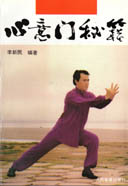 |
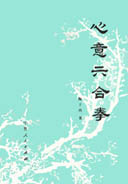 |
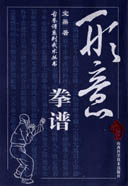 |
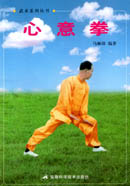 |
End of "Xinyi Liuhe Quan - The Secret Art of Chinese Muslims - Part One - Brief History"; © J.Szymanski 2000-2002 THE NEXT ARTICLE WILL INTRODUCE THE FEATURES, TECHNIQUES AND PRACTICE METHODS OF XINYI LIUHE QUAN |
Home ▪ About me ▪ Updates ▪ Taiji ▪ Bagua ▪ Xinyi-Xingyi ▪ Other Styles ▪ News ▪ Store ▪ Community ▪ Email